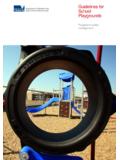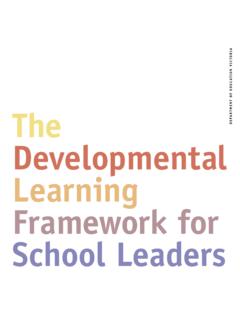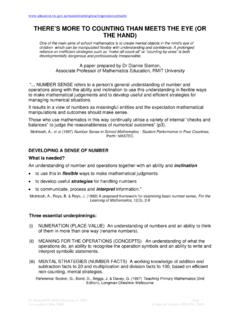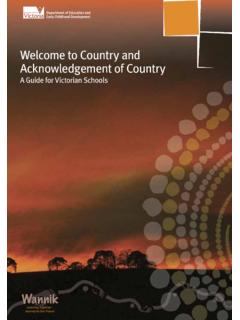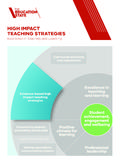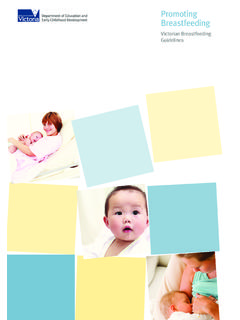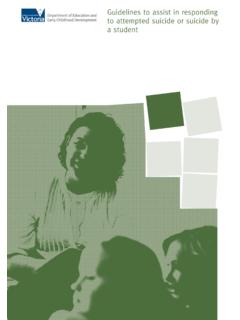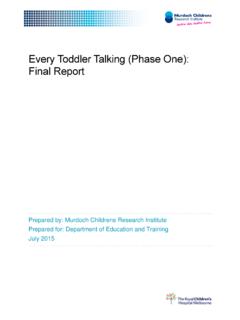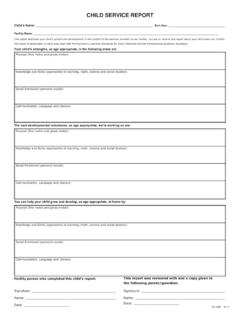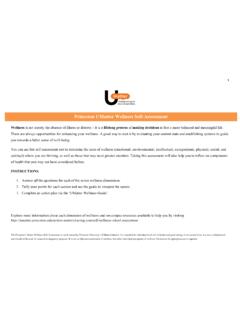Transcription of Wellbeing Social Emotional Learning Activities
1 Wellbeing Activities and conversation starters for teachers of primary school-aged childrenThere are a range of Activities that will help build and maintain students Wellbeing . The Activities cover six key elements that are important to Wellbeing . These Activities are based on the optional Resilience, Rights and Respectful Relationships teaching and Learning literacy Understanding emotions helps students to understand themselves and other people. We can do this by focusing on recognising, expressing and managing emotions. Understanding emotions is key to building empathy and self-awareness. Six key elements that are important to wellbeingPersonal strengths Help to build students ability to recognise and understand positive qualities in themselves and others.
2 This will help to build your students self-confidence and their capacity to face and manage challenges. Positive coping Provide opportunities for your students to discuss and learn different types of coping strategies. This will increase your students ability to manage stress, control impulses and overcome obstacles. Problem solving Students can develop their critical and creative thinking skills to explore different types of problems. This can build your students ability to make responsible decisions that consider the likely consequences of different ways of solving management Learn about different calming strategies to deal with stress. This can help your students to cope with challenges they are facing now and in the future.
3 Help seeking In these challenging times, it is important to normalise asking for help. Students will learn to recognise situations in which to seek help, how to identify trusted people in their lives to ask for help and practice asking for and providing help. Wellbeing Activities and conversation starters for teachers of primary school-aged childrenEmotional literacy Learning intention: Students recognise and name some commonly experienced emotions Students identify what the emotions look like through facial and body expressionsActivity: What do emotions look like? Reading a story that illustrates different emotions Full instructions: Page 5 of Resilience, Rights and Respectful Relationships - FoundationFor students in Foundation level Personal strengths Learning intention: Students explore what it feels like when they have to do something they are afraid of Students explore what bravery looks likeActivity: What does being brave look like?
4 Using drawings to explore personal strengths that can be used when children feel nervous or scared Full instructions: Page 12 of Resilience, Rights and Respectful Relationships - FoundationPositive coping Learning intention: Students learn self-talk techniques to understand and manage their emotionsActivity: Managing emotions A statue game that encourages children to think about what can help them feel calm or happy Full instructions: Page 21 of Resilience, Rights and Respectful Relationships - FoundationProblem solving Learning intention: Students recognise that problems are a normal part of life Students increase their ability to identify and name problems Students recognise that there are solutions to problems Activity: The picnic problem solving game Uses the scenario of preparing for a picnic to explore finding solutions for different problems Full instructions: Page 24 of Resilience, Rights and Respectful Relationships - FoundationStress management Learning intention: Students identify Activities that can help them to reduce their stress levelsActivity: The picnic problem solving game Students share ideas of how they like to calm down or cheer up and draw pictures to show one of their coping strategies Full instructions.
5 Page 30 of Resilience, Rights and Respectful Relationships - FoundationHelp seeking Learning intention: Students identify people who they can go to for help Students identify people who they can share their good times withActivity: My helpful people Uses drawings for students to identify who they would share happy news with and who to ask for help Full instructions: Page 33 of Resilience, Rights and Respectful Relationships - FoundationWellbeing Activities and conversation starters for teachers of primary school-aged childrenFor students in Years 1 and 2 Emotional literacy Learning intention: Students name some of the commonly experienced emotions Students identify the ways in which emotions are shown in body language Activity: Emotions statues A statue game that encourages students to think about the causes of different emotions and recognise when others express their emotions Full instructions: Page 4 of Resilience, Rights and Respectful Relationships - Years 1 and 2 Learning intention: Students identify experiences that can trigger particular emotions Activity: Emotion triggers Uses drawings for students to show how experiences can cause emotions Full instructions: Page 5 of Resilience, Rights and Respectful Relationships - Years 1 and 2 Personal strengths Learning intention.
6 Students describe the kinds of actions that generate a sense of pride or accomplishment Students identify key strengths used in the school setting Activity: Strength detectives Uses a scenario to encourage students to think about what sorts of experiences can lead someone to feel proud of themselves Full instructions: Page 9 of Resilience, Rights and Respectful Relationships - Years 1 and 2 Learning intention: Students describe how to use strengths to be a good friend and family member Activity: Building the strengths display Creates a display of strengths from words, pictures and photographs in the classroom based on students individual strengths Full instructions: Page 10 of Resilience, Rights and Respectful Relationships - Years 1 and 2 Positive coping Learning intention: Students explore the difference between calming and cheering coping strategies Students identify times when they need to use calming or cheering coping strategies Activity: Cheering up and calming down Uses music to explore strategies for students calm themselves down or cheer themselves up Learning intention: Students identify situations that can cause fear Students select coping strategies to help deal with their fears Activity: Facing fears Uses nursery rhymes and books to help students identify fears and explore coping strategies Full instructions.
7 Page 20 of Resilience, Rights and Respectful Relationships - Years 1 and 2 Wellbeing Activities and conversation starters for teachers of primary school-aged childrenProblem solving Learning intention: Students describe the cooperative behaviour that helped the team to succeed in the activity Students identify how the cooperative behaviour can help with solving problems Activity: Let s work together: cooperative games Uses two games that encourage teamwork to explore solutions to different problems and how it can be applied in the classroom Full instructions: Page 25 of Resilience, Rights and Respectful Relationships - Years 1 and 2 Learning intention: Students use the problem-solving model to help them identify options for children experiencing problems Students identify possible sources of help Students describe and enact problem-solving and help-seeking strategies Activity: Real world problems Uses different scenarios to explore different options to address problems and consider upsides and downsides Full instructions: Page 27 of Resilience, Rights and Respectful Relationships - Years 1 and 2 Stress management Learning intention: Students develop a definition of stress Student recognise how stress can be felt in the body Students identify experiences that can cause feelings of stress Activity: What is stress?
8 Asks students to think about how stress is felt and its causes, using a character named Wibbly Full instructions: Page 31 of Resilience, Rights and Respectful Relationships - Years 1 and 2 Learning intention: Students choose favourite strategies for dealing with the fears, anger and sadness Activity: Coping with stress Asks students to think about ways to calm down or cheer up, using a character named Wibbly Full instructions: Page 34 of Resilience, Rights and Respectful Relationships - Years 1 and 2 Help seeking Learning intention: Students practise skills in peer helping Activity: I can help my friends Uses scenarios to encourage students to think of ways they can provide help to other children in need Learning intention: Students discuss the types of situations in which they would be best to seek adult assistance Students understand the importance of finding the language to name problems when help-seeking Activity: How do I ask for help?
9 Uses scenarios and role-play to explore ways in which children can ask an adult for help Full instructions: Page 47 of Resilience, Rights and Respectful Relationships - Years 1 and 2 For students in Years 1 and 2 continuedWellbeing Activities and conversation starters for teachers of primary school-aged childrenFor students in Years 3 and 4 Emotional literacy Learning intention: Students develop their vocabulary to identify and describe their emotions Students identify the ways in which emotions are shown in body language Activity: The emotions echo game The game explores emotions and body language and asks students to think about how they can work out what emotions other people are experiencing Full instructions: Page 4 of Resilience, Rights and Respectful Relationships - Years 3 and 4 Learning intention: Students develop their vocabulary to identify and describe their emotions Students identify and demonstrate the ways in which emotions are shown in body language Students enhance their ability to recognise emotions in others Students identify the types of events and situations that are associated with positive and negative or comfortable and uncomfortable emotions Activity: What do emotions look like?
10 Creates freeze frames and role play to show a situation where someone might feel certain emotions, then asks students to guess the emotions Full instructions: Page 5 of Resilience, Rights and Respectful Relationships - Years 3 and 4 Personal strengths Learning intention: Students develop an understanding of the concept of personal strengths Students identify and name their personal character strengths Students recognise how different strengths help people to learn and thrive Activity: What are personal strengths? In small groups, students discuss character strengths and what actions people take who are showing that strength Full instructions: Page 13 of Resilience, Rights and Respectful Relationships - Years 3 and 4 Learning intention: Students describe the personal character strengths that people use in their everyday lives Students identify examples of ways in which strengths can be seen in the actions people take Students identify the strengths that they would like to further developActivity: Strengths we use every day
